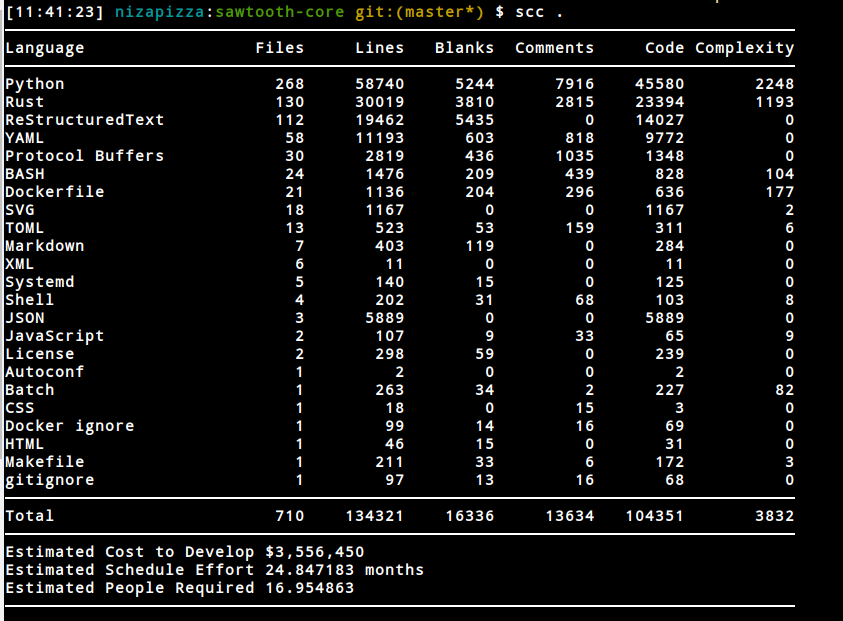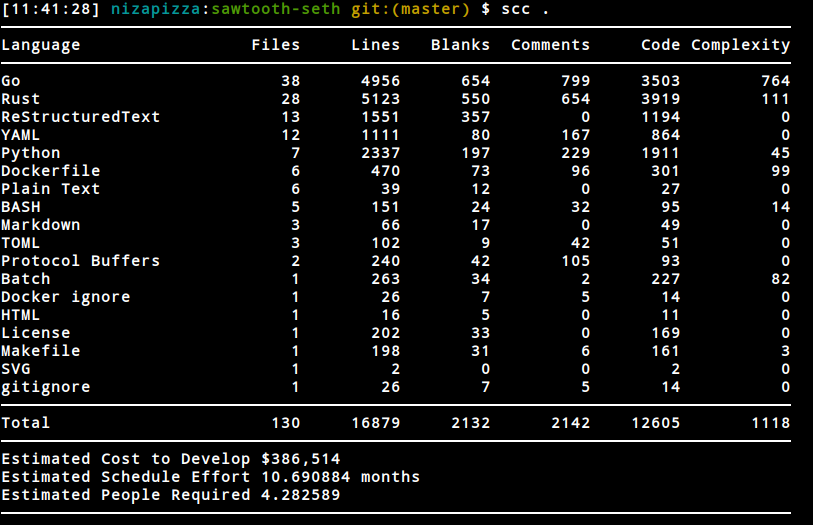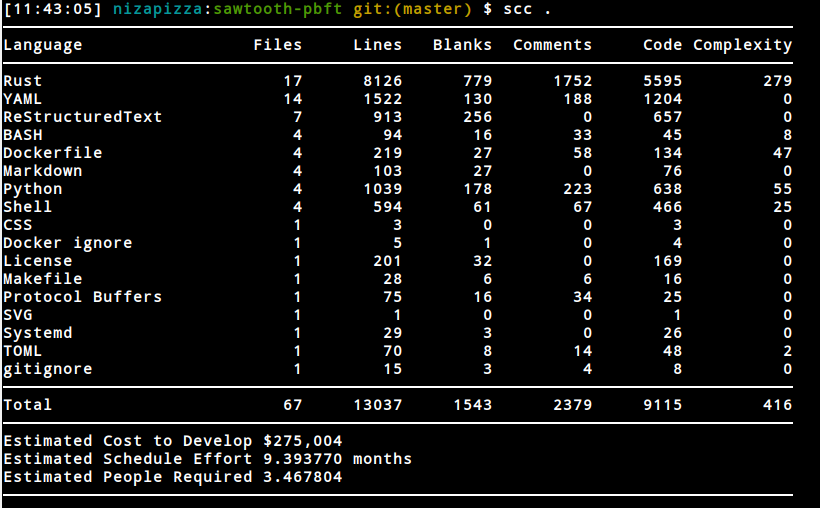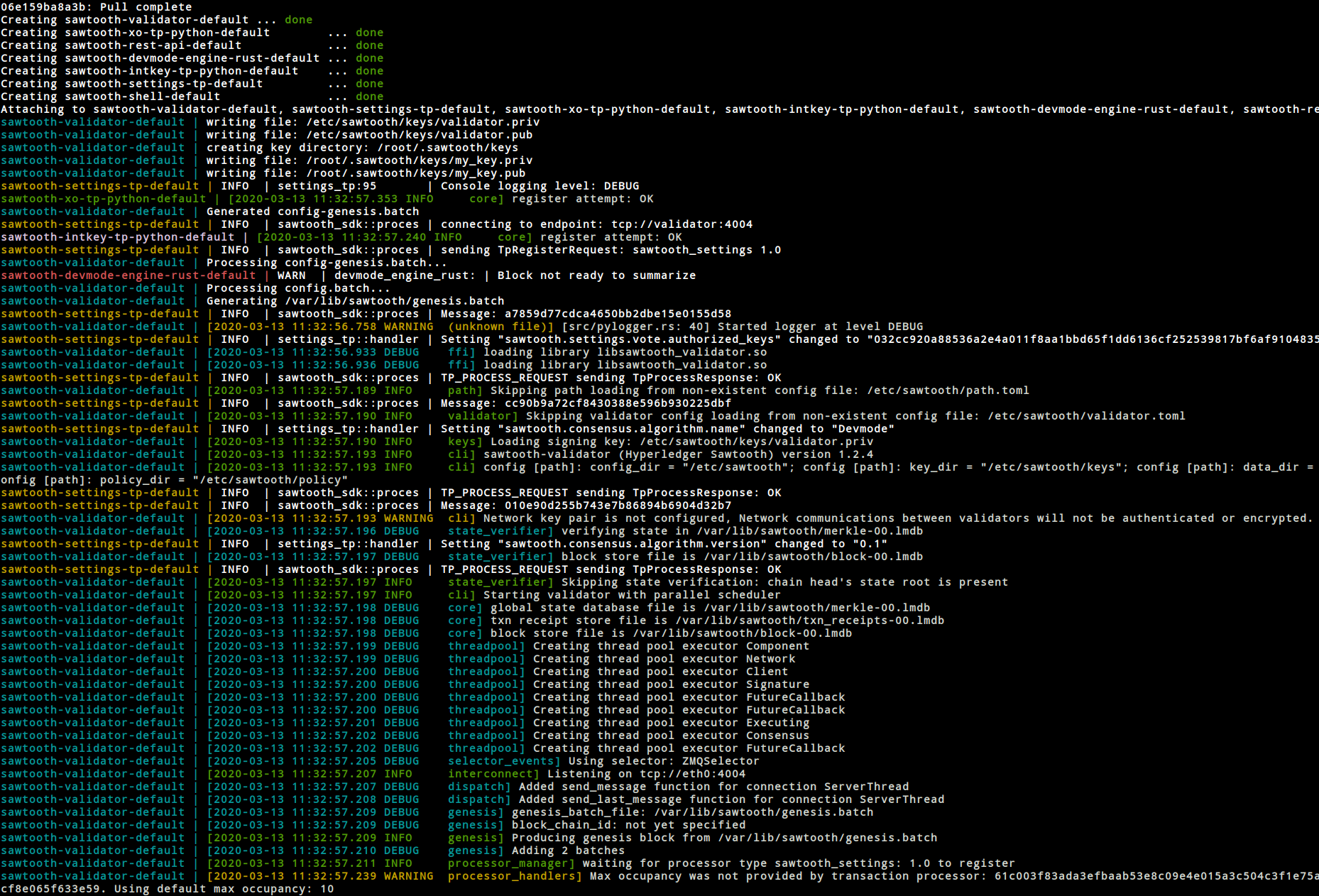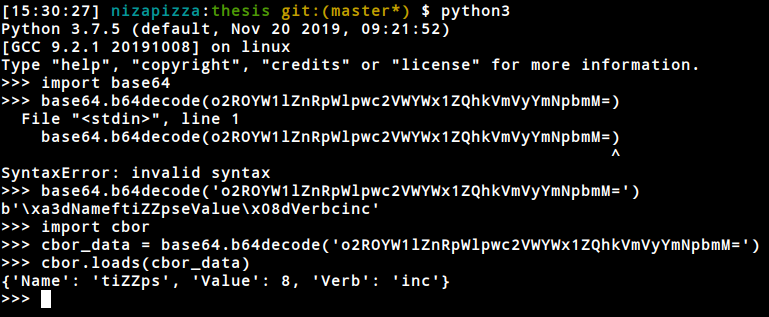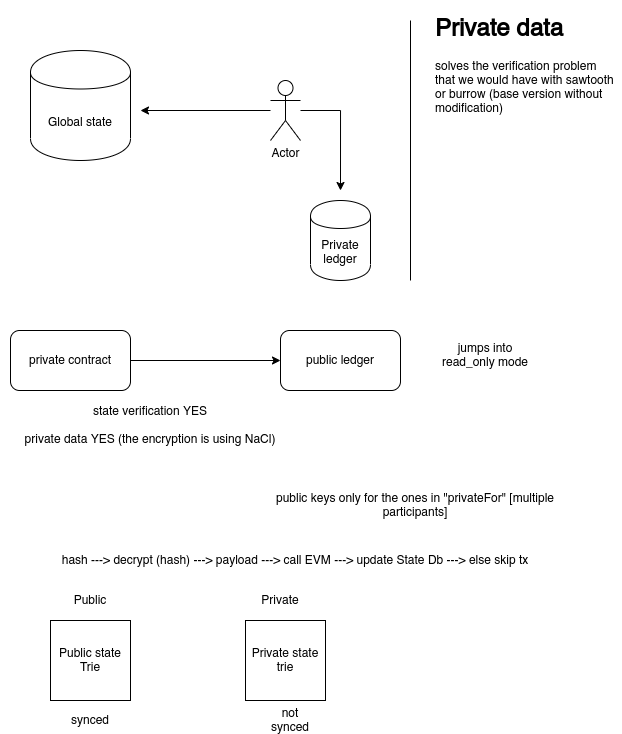potential project
aa write a framework that tests the transaction processors
-
background and fundamentals - data strucutre - mining - merkle trees - patricia trees - modified merkle-patricia - cryptography - Elliptic curve - ECDSA - common loopholes
-
decentralized / distributed nature - p2p - consensus - zkp - pow - pos - byzantine fault tolerance
-
Ethereum and smart contracts - btc vs eth - smart contracts in general - evm - Scalability - Economics of Smart Contracts - Security of Smart contracts
-
x Hyperledger - The foundation and the hp ecosystem - Hyperledger fabric - Hyperledger sawtooth - Why we used it - Hyperledger delve
-
x Quorum - What problem does it solve - The architecure and the tech behind it (mention alternatives as well) - Why was sawtooth not fit for us
-
x ChorChain integration - on BPMN - on ChorChain - EVM smart contracts being deployed there
-
Conclusion - What were the steps involved
-
[Crypto quotes] (https://github.com/openblockchains/crypto-quotes)
-
[awesome blockchains] (https://github.com/openblockchains/awesome-blockchains)
- transactions act as an incentive for miners to include information on the block.
- allthough, much of that is based on speculation. Naked money talks about it in one of its chapters.
- digital signatures can ensure that a new public key can only be posted by the holder of the secret key. Signatures and smart contract have that in common conceptually.
- there are interactive and non-interactive zero-knowledge proofs
- ali baba cave example, zero proofs in the mathematical send of the term because there is a small probability, the soundess error.
- computationally indistinguishable given an auxiliary string between verifier and prover
- Secure remote password has a zero-knowledge
- Find a hamiltonian for a large graph is considered infeasible and is NP complete.
- Np complete
- Decision problem
- merkle tree
- merkle trees in eth
- merkle patricia tree
- Bloom filter
- merkle radix
- this happens when there is an attack Gambler ruin
- Gambler's falacy
- Random walks
-
fabric only supports permissioned
-
fabric has fine-grained governance over participation
-
sawtooth supports permissioned and permissionless blockchain network
-
sawtooth defines roles and permissions which make it more flexible than fabric and auth is handled by validators in the network.
-
ledger
-
distributed
-
secure
It's divided in two main layers
- app layer : this one can be anything
smart contracts virtual machine or a Business logic that is native to the problem.
- core layer
contain multiple transactions. (in bitcoin transactions are atomic). the header is the thing that gets signed
-
validator makes sure the hash : payload_sha512 is the same as the payload. to make sure that no one changed the contents of the payload.
-
public keys of both signer of batch and signer of transaction, prevents different transaction in different batch.
-
family_name and family_version: routing information, to which transaction processors should I send this tx.
-
inputs and outputs: addresses of state that we will be writing to (client needs to understand the same logic as tp. they kind of need to agree on how to calculate those addresses in that way the validator will do a better job in parallelizing the job).
-
dependencies: other transactions that we need to wait on, not in the same batch
-
the client encodes the data in a payload. the tp needs to decoded and it will encode some stuff in state
-
the client needs to decode the data in state.
-
70 hex chars to play with , first 6 name space of transaction family. 64 whatever you want ( a hash of a UUID ).
-
with the merkle tree you can fetch anything under a prefix. anything that matches the namespace prefix. (you can create subname spaces).
the transactions go through these transaction processors for their unique requirements.
-
Transaction processors sdks: python, javascript, go, c++, java and rust.
-
these validators communicate with external things through standard HTTP/JSON.
-
advanced parallel scheduler that splits transactions into parallel flows.
-
we are preventing double spending obviously
-
they are always wrapped in a batch, then submitted to the nodes to change the global state of the chain.
-
batches are the unit of state change not transactions
-
txs are wrapped inside of batches
-
serialization is important, otherwise when the nodes (validators), some would consider them to be valid and some would not consider them valid, investigate the potential effects of that.
-
for serializing, look into protocol buffers
-
secp256k1 curve and ECDSA key using that curve, read into that.
-
journal system, blockPublisher and chainController for block validation and fork resolution.
-
use the original header bytes for verification. don't deserialize and reserialize, any deviation can break things. stick to reading the original header bytes and verify them before pushing them again
-
normalization Bitcoin Transaction Malleability
- sawtooth can create and broadcast event.
- Subscriptions are done over a ZMQ Socket
The transaction process kind of acts as a smart contract
you can have both TPs + smart contracts. easy logic = tp unsusual logic = smart contract
Supply chain : talks directly to validator Local database: redundancy
client = create transactions and batches and submit them. anything really. mobile cli web whatever either through the built-in rest or like supply chain approach
Hyperledger burrow + sawtooth = runnable smart contracts written in solidity
-
[Seth] (https://sawtooth.hyperledger.org/docs/seth/releases/latest/seth_transaction_family_spec.html)
-
! Important, make sure to add the reference for the docker volume in the docker-compose.yaml file in the sawtooth-seth folder. The volume is not added on the original compose file. Hence the seth-rpc program can't find the alias keys needed to unlock the accs through the rpc. I think it's because there are two version of the seth-cli, one in rust and one in go.
- with Poet SGX, you get hardware assistance which means you can achieve BFT that POW gives you if you have Intel chips
- normal Poet, you ensure Crash fault tolerance not Byzantine fault tolerance (all data is correct, can't ensure bad actors).
The algorithm does not rely on synchrony to provide safety. Therefore, it must rely on synchrony to provide liveness; otherwise it could be used to implement consensus in an asynchronous system, which is not possible
It is not feasible to offerfault-tolerant privacy in the general case because service operations may perform arbitrary computations using their arguments and the service state; replicas need this information in the clear to execute such operations efficiently
uses a round robin simple scheduler.
Sawtooth uses InfluxDb to store metrics data. That data gets fed then to grafana. An alternative technology to that would be Prometheus. It uses a pull system instead of a push and is maybe more performant.
For example, the ‘inc’ and ‘dec’ transactions must list the initial ‘set’ transaction for the entry. If an ‘inc’ or ‘dec’ transaction is ordered before the corresponding ‘set’ transaction (without listing the ‘set’ transaction as a dependency), they will be considered invalid (because Name will not exist when they are processed).
Hyperledger fabric uses a channel method as well as R3 Corda's and JPMorgan Quorom. through separation of concerns: The key disadvantage of this model is that it creates a number of ‘sub-chains’ and transferring assets between these chains adds significant complexity or reduces confidentiality
UTXO are unspent transaction outputs.
When off-Ledger, the assets are represented as a document. This document holds the details of the assets. The sha512 hash of this document is the UTXO handle. In this case, the document is in a very real sense the asset that is being represented. Having access to the document will provide the details of the asset and who owns it. As such, it is important that the document is kept secret and protected. UTXODocument is considered valid when there is a matching UTXO record in the DLT. If there is not a matching entry in the DLT then the Asset has either been consumed or has not yet be recorded with Convert to UTXO or Transfer UTXO transactions.
- Supply chain (tracking telemetry, goods logistics)
- Marketplace (asset exchange)
Docker containers overview
CONTAINER ID IMAGE COMMAND CREATED STATUS PORTS NAMES
7aff0b07f31c hyperledger/sawtooth-shell:chime "bash -c 'sawtooth k…" 12 minutes ago Up 12 minutes 4004/tcp, 8008/tcp sawtooth-shell-default
46daf836f0b1 hyperledger/sawtooth-devmode-engine-rust:chime "devmode-engine-rust…" 12 minutes ago Up 12 minutes sawtooth-devmode-engine-rust-default
418eb0e0b694 hyperledger/sawtooth-intkey-tp-python:chime "intkey-tp-python -v…" 12 minutes ago Up 12 minutes 4004/tcp sawtooth-intkey-tp-python-default
33756075952e hyperledger/sawtooth-settings-tp:chime "settings-tp -vv -C …" 12 minutes ago Up 12 minutes 4004/tcp sawtooth-settings-tp-default
a79044b9b475 hyperledger/sawtooth-rest-api:chime "sawtooth-rest-api -…" 12 minutes ago Up 12 minutes 4004/tcp, 0.0.0.0:8008->8008/tcp sawtooth-rest-api-default
1f540d690033 hyperledger/sawtooth-xo-tp-python:chime "xo-tp-python -vv -C…" 12 minutes ago Up 12 minutes 4004/tcp sawtooth-xo-tp-python-default
32bd01887eee hyperledger/sawtooth-validator:chime "bash -c 'sawadm key…" 12 minutes ago Up 12 minutes 0.0.0.0:4004->4004/tcp sawtooth-validator-default
Initial outputs
{
"header":{
"signer_public_key":"032cc920a88536a2e4a011f8aa1bbd65f1dd6136cf252539817bf6af9104835239",
"transaction_ids":[
"07d274ee533882af479bb4fe751e35c07250f3c4a2f840dda4d35e5173621e7e0819b7b418f8b6a3ddd27a62d33d6cbff0a25ece01e61a75ad33d73713674bf4"
]
},
"header_signature":"4663f9969f8ffca7671f3614aac63a2121c7167ef79545dd8db2b8a35060c02b6339da23c19187c5adfa1c68f51b5b7a2c288d12f2bf44754b4e3e19ef769f8a",
"trace":false,
"transactions":[
{
"header":{
"batcher_public_key":"032cc920a88536a2e4a011f8aa1bbd65f1dd6136cf252539817bf6af9104835239",
"dependencies":[
],
"family_name":"sawtooth_settings",
"family_version":"1.0",
"inputs":[
"000000a87cb5eafdcca6a8cde0fb0dec1400c5ab274474a6aa82c1c0cbf0fbcaf64c0b",
"000000a87cb5eafdcca6a8cde0fb0dec1400c5ab274474a6aa82c12840f169a04216b7",
"000000a87cb5eafdcca6a8cde0fb0dec1400c5ab274474a6aa82c1918142591ba4e8a7",
"000000a87cb5eafdcca6a8cde0fb0dec1400c5ab274474a6aa82c12840f169a04216b7"
],
"nonce":"",
"outputs":[
"000000a87cb5eafdcca6a8cde0fb0dec1400c5ab274474a6aa82c1c0cbf0fbcaf64c0b",
"000000a87cb5eafdcca6a8cde0fb0dec1400c5ab274474a6aa82c12840f169a04216b7"
],
"payload_sha512":"67e831a4896b7200c23df514393cfa7d3c5294328cd4717561d7bb8e0e70605310602326e2028be20f36c39e034839eefdd2abe18e9a78f6979753afadddabf6",
"signer_public_key":"032cc920a88536a2e4a011f8aa1bbd65f1dd6136cf252539817bf6af9104835239"
},
"header_signature":"07d274ee533882af479bb4fe751e35c07250f3c4a2f840dda4d35e5173621e7e0819b7b418f8b6a3ddd27a62d33d6cbff0a25ece01e61a75ad33d73713674bf4",
"payload":"CAESfwomc2F3dG9vdGguc2V0dGluZ3Mudm90ZS5hdXRob3JpemVkX2tleXMSQjAzMmNjOTIwYTg4NTM2YTJlNGEwMTFmOGFhMWJiZDY1ZjFkZDYxMzZjZjI1MjUzOTgxN2JmNmFmOTEwNDgzNTIzORoRMHhmM2RmOTI3NmM3YjcwYjc="
}
]
}
If you go to the scripts folder you'll find a simple script that shows how to decoded a cbor payload using the cbor python package.
now if you interact directly with the sawtooth tool you only get the cbor back but when requesting from the REST API they first encoded in base64 encoding then you can decode it to cbor format
- run multiple instances of the containers
- try to run the smallbank transaction processor in this network and see how it works.
NOTE TO SELF: instead of going to github looking for the Dockerfile directly. go to hyperledger's dockerhub
Online transanction processing. Interesting read this
HStore website. They are behind the smallbank-tp. It's mainly used for testing and benchmarking purposes.
so for each Transaction processor, we need to write a client that handles that encoding and serialization and sends it to the REST API.
so if we are writing the client we need the PROTO compiler to compile the .proto files so that we can use them to serialize the stuff properly
Python grpc. they use different tools to compile their protobuffs. documentation is really weird
so Far we are trying to solve the issue of private transactions. The first problem is that if a tx is private, which means only some actors can see it, that means there is no way to proove the validity of that node. Since we can't validate it's hash and compute the validity of it. So I investigated couple of solutions that could be potentially interesting
- PDO SGX
- UTXO (deprecated on sawtooth, was used on version 0.8)
- write a Proxy that would have a key-value store with permissions (classical db that would make the private ledger)
- Hyperledger Indy (Sovrin)
- Quorum
This the repo
- It needs specific hardware, the issue with this solution so far is that the contracts are written in a weird language (Gypsy scheme). So we loose our ETH smart contracts compatibility. With the solidity scripts generated by Chorchain.
- The solution seems also very technical and seems to lack a higher abstraction. It's very very technical, kind of beyond the scope of one person.
- Requires special hardware (allthought most processors these days have the SGX on Intel chips). There is also a simulated mode but that's still a minus in my opinion. Vendor-locking is usually not a good idea. (Decentralization doesn't stand behind this idea at least)
- this is basically a way to take things off-chain. Which seems kind of analogous to channels in Fabric. But it's not supported and became deprecated
- Proofs are written to the ledger, while the computation is executed offchain.
- The idea is simple, we could write a third party system that would stand before data comes in the sawtooth or burrow node.
- The problem is that there are probably solutions to this problem already.
- advantage is that we can support ETH smart contract style in solidity. through sawtooth-seth or directly through a burrow chain
- Difficult to implement and would probably be buggy or not secure. Sounds like a team effort rather than a single person's workload
- has this notion of private data
- relies on cryptography
- the main usecase revolves around real documents (driver licenses, IDs ... ).
- Does not really fit in our use case where we need ETH compatibility and Private transactions.
- It's more oriented to legal documents
- has Solidity smart contracts
- has this notion of private data, where there are two different ledgers. One for public data and one for the private stuff.
- Seems so far the ideal solution so far.
- JPMorgan backed. It's essentially there fork of Ethereum, so the tooling is kind of up to date to the eth ecosystem.
- it only sends the data to whoever needs it, instead of having populating databases (quorum) or creating a million side-channels
-
essentially with fabric channels, you end up with 100 000 subchannels, and that slows the network a lot
See if you can implement a system based on pub-priv key encryption at least to hide the data from users that are not supposed to see it.
If you can't see the transaction as a part of the chain, you can't validate it, so you loose validitiy
- full privacy == loss of validity
This I think goes against the purpose of the blockchain as an idea, it feels like you are trying to force a certain technology regardless of its fit in the current context.
- write a transaction processor that mimicks the idea of a Tessera node with an enclave. Notice how the Transaction processors are adjacent to the Validator. It looks very much like a The quorum node and the tessera node communication.
- encrypt the data with another box
- for now, the data will be stored on chain (maybe we could find a way to offload the storage offchain in the future)
- broadcast the encrypted payload via encryption for now (i'm sure there are distributed systems mechanims that could achieve that, but let's stick with the basic idea here that is of achieving private data on sawtooth)
- Enclave in quorum = Private-tp on sawtooth
- Private-tp : would handle all the encryption of payloads according to a privateFor key that would be the public keys of the entities that could decrypt it using their private key
- achieve private key-value payloads.
- encrypted EVM code. make sure to decrypt it before it is used by sawtooth-seth or something
- figure out how basic encryption is done with the pair keys on sawtooth
- write the TP that encapsulates that mechanism
go to the folder private_data/ and look for the script public_encryption
- using coincurve we can use the keys stored at /root/.sawtooth/keys/*.pem to generate encrypted payload that we can then store on the chain, meaning that we would need to encrypt the payload for n amount of privateFor people.
- you need two main libraries
# the encrypt and decrypt method
pip3 install eciespy
# the Coincurve.PrivateKey object, generate this object from the hex
pip3 install coincurve
The next step is to implement this logic inside a transaction processor
